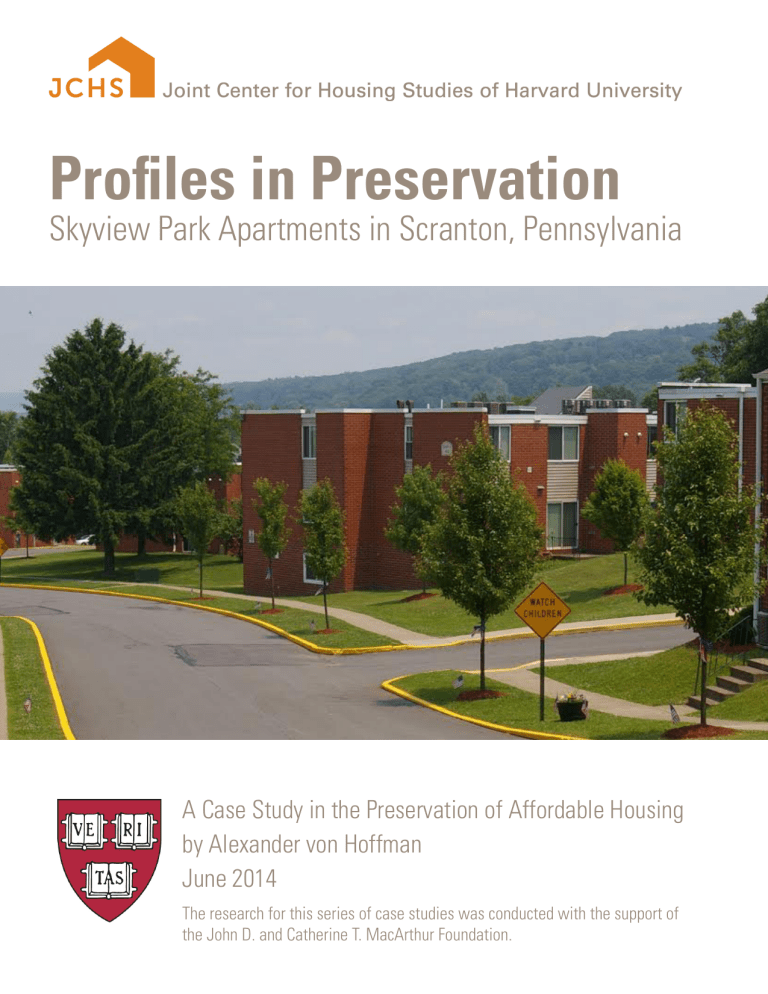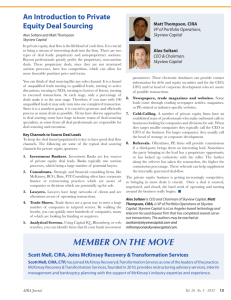Profiles in Preservation Skyview Park Apartments in Scranton, Pennsylvania

Profiles in Preservation
Skyview Park Apartments in Scranton, Pennsylvania
A Case Study in the Preservation of Affordable Housing by Alexander von Hoffman
June 2014
The research for this series of case studies was conducted with the support of the John D. and Catherine T. MacArthur Foundation.
Joint Center for Housing Studies
Harvard University
Skyview Park Apartments in Scranton, Pennsylvania
A Case Study in the Preservation of Affordable Housing
Alexander von Hoffman
June 2014
W14-4
The research for this working paper was conducted with the support of the John D. and Catherine T.
MacArthur Foundation.
© 2014 by Alexander von Hoffman. All rights reserved. Short sections of text, not to exceed two paragraphs, may be quoted without explicit permission provided that full credit, including © notice, is given to the source.
Any opinions expressed are those of the authors and not those of the Joint Center for Housing Studies of
Harvard University or of any of the persons or organizations providing support to the Joint Center for
Housing Studies.
Preface
The following case study is one of a series of five investigations of projects conducted by nonprofit organizations to preserve affordable rental housing in the
United States. These profiles were undertaken to illuminate the characteristics of subsidized housing and the process by which they are preserved — that is to say, refinanced and renovated.
The five subjects of the case studies were selected to represent a variety of geographic locations, communities, and real estate markets; a range of types of tenants: e.g., family, elderly, and formerly homeless; and different types and sizes of nonprofit owner organizations.
Each case explores the history of the particular property and its locale; the history of the organization that owned the property and how it came to own and preserve the property; the methods and challenges of renovating and refinancing the property; and the overall results of the preservation effort. The five profiles in preservation are part of a larger research project supported by the John D. and Catherine T. MacArthur
Foundation, whose support the Joint Center for Housing Studies gratefully acknowledges.
Introduction
On July 7, 2009, the owners of Skyview Park Apartments on the South Side of
Scranton, Pennsylvania, held a public ceremony featuring the mayor of Scranton for residents and neighbors to celebrate the re‐opening of the residential complex. The festivities marked the completion of a redevelopment of the project that provided new kitchens, baths, doors, and appliances to each of the complex’s apartments; a new community center equipped with fitness equipment, computers, and a police sub‐ station; and the replacement of the property management company.
The new owners had “preserved” Skyview Park as affordable rental housing, because at the time they acquired the property its subsidies had expired and the former owner wanted to sell it off. But just as importantly, the renovation, improvements, and new property manager had rescued a place and its residents. Since the 1990s Skyview
Park had been considered one of the city’s most dangerous areas. For that reason, state and city government housing officials embraced the project’s redevelopment and allocated all available funds to help make it possible. The thoughtful restoration of
Skyview Park had turned it into one of the most desirable places in which a low‐income
Scranton family could make a home.
The following case study illuminates the significance of preserving affordable housing in an environment with large working‐ and middle‐class populations and a relatively stagnant economy.
1
Locale: An Old Gritty City
Scranton, Pennsylvania is an old industrial city that has long been in a slow decline.
Thanks to iron and coal mining, it grew during the late nineteenth century to become the third most populous city in the state. During the first decades of the twentieth century, Scranton became a major center of the anthracite coal industry and home to ancillary industries as well as other manufacturing, ranging from silk textiles to phonograph records. The first city in the nation to use electricity to run street cars and an early adopter of electric lighting for its streets, booming Scranton became known as the Electric City.
In the later twentieth century, however, the nation shifted its primary energy source from coal to oil and natural gas, and many textile manufacturing facilities moved to the
American South and to other countries. The Scranton‐Wilkes‐Barre‐Hazelton region has managed to retain some manufacturing. Surprisingly, there is in downtown Scranton an active World War II‐era munitions plant. The region has attracted some new economic activity, albeit of a low‐wage sort, in the form of wholesale distribution centers. The city has experienced modest economic revitalization, in part as a center of tourism for the nearby Poconos Mountains.
The loss of jobs and the area’s tradition of political corruption took its toll on the city’s finances. In the early 1990s, the Commonwealth of Pennsylvania imposed a reorganization of local government, tax hikes, and revision of municipal labor contracts, which helped stabilize the city’s fiscal status.
1 http://www.city‐data.com/us‐cities/The‐Northeast/Scranton‐History.html.
2
Because of its declining economic fortunes, Scranton has been losing people since the onset of World War II. The city’s population peaked at 140,400 in 1940, declining every decade since. The number of inhabitants dropped further to 103,500 in 1970, and fell subsequently to 76,400 by 2000. Since then the loss of population has been minimal, as the departure of whites has been balanced by the arrival of immigrants from foreign countries and members of racial minority groups from the East Coast.
Despite the movement of people in and out of the city, Scranton’s population remains heavily white. The 2010 census recorded that 84 percent of the inhabitants are white, 5.5 percent are African American, and 3 percent are Asian. Persons identified as
Hispanic make up 10 percent of the population.
Given the industrial character of the regional economy, Scranton’s population has been heavily working class. Nonetheless, Scrantonians’ income has been declining, even in relation to the residents of suburbs in this industrial region. In addition, Scranton’s poverty rate has climbed from 13 percent in 1980 to 20 percent in 2010.
Rates of poverty are very high among African Americans (44 percent) and Hispanics (26 percent), while lower but still relatively high among whites (16 percent). Because whites make up the majority of the population, they are also by a wide margin the most numerous of the poor residents (about 9,000 poor whites as opposed to about 900 blacks and 700
Hispanics).
2 United States Census Bureau, SOCDS Census Data: Output for Scranton City, PA, http://socds.huduser.org/census/incpov.odb; US Census Bureau, Scranton (city), Pennsylvania http://quickfacts.census.gov/qfd/states/42/4269000.html.
3 http://www.city‐data.com/poverty/poverty‐Scranton‐Pennsylvania.html.
3
Because the decline of Scranton has been gradual, the city has been able to hold on to some of the amenities of urban life. Unlike some larger cities, for example, it has a daily newspaper. Its neighborhoods, while not as bustling as they once were, are occupied by families and contain local taverns, restaurants, and shops. It has a small but lively music scene and a local professional theater company. Its downtown has many historic commercial structures, some with vacancies and others fully occupied, and a large indoor shopping mall, whose anchor department store the local inhabitants say is struggling to stay open.
Skyview Park Apartments – A Brief History
Skyview Park Apartments is a small apartment‐building subdivision occupied by low‐ income family and individual renters. The compound contains 188 one‐, two‐, and three‐bedroom apartments in brick one‐ and two‐story buildings scattered around the sloping site.
Although it is common to picture low‐income housing in city neighborhoods, this subsidized housing project was placed, as many such developments are, on a self‐ contained site that was cut off from the rest of the city. It is located on a cul‐de‐sac road on a ridge that runs along the edge of the working‐class South Side neighborhood
(also known as South Scranton). By automobile one can only arrive and depart Skyview
Park by way of Gibbons Street, which connects the compound to the grid of South Side streets. On the three other sides, Skyview Park is surrounded by woods. Past a thin stretch of forest to the northeast is a public housing development, Valley View Terrace,
4
also located on a cul‐de‐sac road; to the southwest, on the other side of community baseball fields and some woods is Hilltop Manor, another public housing project. To the south and southeast of Skyview Park are a steep incline, dense forest, and U.S.
Interstate Highway 81. The affordable housing complex is thus relatively isolated from the rest of the city of Scranton, except for these two public housing estates.
Skyview Park Apartments was built in 1973 by a company called Skyview Park
Associates, a limited partnership whose principal office was in Beverly Hills, California.
The previous year the partnership had taken out a forty‐year mortgage of $3,267,600, which was insured by the federal Department of Housing and Urban Development
(HUD) under Section 236 of the National Housing Act. At the same time, Skyview Park
Associates signed an agreement to abide by HUD’s regulations for the Section 236 program. Section 236, which was operative from 1969 to 1974, provided subsidies for mortgage interest payments and mortgage insurance that allowed owners to set rents for low‐ and moderate‐income tenants at amounts no greater than 25 percent of the tenants’ income.
In the subsidized housing field, the common practice has been for the various investors in a project – be they individuals or companies – to form a unique entity to develop and own each individual property. Usually the principal or general partner of the housing’s ownership managed the project, and the limited partners brought equity capital into the deal. This research has not yet uncovered the identities of the partners
4 Mortgage Note, between Skyview Park Associates and Mellon National Bank and Trust Company,
Scranton, Pennsylvania, July 20, 1972; Regulatory Agreement for Limited Distribution Mortgagors under
Section 236 of the National Housing Act, As Amended, Project No. 034‐44082, July 20, 1972. The author is grateful to Mr. Charles E. Allen for making project documents available.
5
who originally developed Skyview Park, but by 1984 a Connecticut businessman, Murray
Haber, had become the general partner. Haber had invested in numerous subsidized housing properties around the country, but also had brought in other investors as limited partners.
While they continued to receive mortgage interest payments from HUD, Skyview’s owners at some point also obtained Section 8 project‐based rent subsidies for all but one of the 188 apartments in the complex. The Section 8 subsidy contracts usually lasted twenty years, after which time the owners could either obtain a new short‐term contract and maintain the low‐income nature of the development or cease to accept the subsidies and convert it to a market‐rate property. The Section 8 contract for Skyview
Park Apartments was due to expire in 2006.
One salient difference between the Section 236 program and Section 8 programs is that the former offered a lower amount of subsidy than the latter. This meant that to make revenue exceed costs under Section 236, owners generally let apartments to households that earned higher incomes than those required by Section 8. The switch to
Section 8 funding, in other words, brought poorer tenants into the Skyview Park complex.
5 Charles E. Allen, telephone interview with author, Ipswich, Mass., March 14, 2013; Amendment to
Regulatory Agreement between Skyview Park Associates and the Secretary of Housing and Urban
Development (HUD), March 1, 1984.
6 The Section 8 program, established in 1974, replaced the Section 236 mortgage‐interest subsidies with direct rent supplements. A special program started in 1976, the Loan Management Set Aside, allowed the use of Section 8 funds to help pay operating expenses for subsidized but financially troubled projects under Section 236 and other programs. Further research would be necessary to discover when and what type of Section 8 subsidies were tapped for Skyview Park. National Housing Trust/Enterprise Preservation
Corporation (NHTE), Skyview Park, Scranton, PA Board Action Request, October 13, 2006; HUD, Project‐ based Section 8 Housing Assistance Payments Basic Renewal Contract, One Year Term, for Skyview Park
(Section 8 Project Number: PA26L000137), November 20, 2007.
6
The property manager for Skyview Park in the 1990s was the Murray Management
Company. Murray Haber, the principal owner of Skyview Park Associates, had started this company and used it at several of his properties. Skyview had other investors, but
Haber and his management company were in charge of the Scranton housing complex.
The Bad Old Days
Haber was happy with his stake in Skyview Park because it generated cash flow from rents and property management fees. Yet while he was a principal owner, Skyview Park fell into abysmal conditions. By the mid‐1990s the managers of Skyview Park seemed to admit anyone who applied and tolerated all manner of activities on the premises. Well into the 2000s, local newspapers regularly reported crimes that either took place or were somehow connected to Skyview. The local reputation of the place was toxic, with people warning their friends to stay away unless they were armed.
Skyview’s fearsome reputation was well earned. Officer Thomas Carroll, who as a rookie officer in the Scranton police force was often assigned to Skyview, calls the 1990s
“the bad old days,” a time when dealers peddled crack cocaine and street gangs fought with guns to control the territory. The police routinely sent its SWAT team with search warrants to Skyview to put down blatant drug dealing, shootings, and stabbings, which sometimes occurred in broad daylight. Once a Girl Scout troop arrived to help with after‐school activities for Skyview’s children only to be greeted by a drive‐by shooting.
Most of the people committing crimes came from elsewhere, particularly the
7
neighboring public housing projects, but the staff felt helpless to stop strangers from wandering onto the premises.
Such dangerous circumstances threatened residents and staff alike. The drug dealers’ lookouts stood in the open talking on their cell phones, but Skyview’s inhabitants were afraid to report them for fear of retaliation. Cautious parents did not let their children stray more than a few feet from the building entrance so they could watch to be sure they were safe. Skyview’s main grounds held little attraction, anyway, lacking a playground.
The property managers were afraid to venture to the apartments to collect the rents.
Hence, violence took a toll on the upkeep of the place. Syringes littered the grounds, and garbage spilled from overfilled cans onto the sidewalks. Despite suburban‐scale areas of open space, the complex appeared shuttered and neglected. Neither residents nor managers planted flowers or shrubs; no window boxes or wreaths adorned the front doors. “There was nothing,” recalls Elaine Donly, a long‐time social worker at Skyview,
“that indicated any kind of pride in the community.”
The management company bore responsibility for Skyview’s abysmal physical conditions, if not its crime. Murray Management Company was a relatively small firm without much money to spend on its sites, yet, according to Donly, the manager did very little with what he had. The apartment of one family, which Donly visited, was
7 Perhaps Skyview reached its nadir in October 1999 when a resident, a crazed young father, killed his two young children. Officer Thomas Carroll, interview with author, Scranton, Pennsylvania, June 11, 2012;
Elaine Donly, interview with author, Scranton, Pennsylvania, June 12, 2012; Jutta Space, interview with author, Scranton, Pennsylvania, June 11, 2012; “D.A.: Dad Says He Killed his Kids and Planned to Commit
Suicide,” The Times Leader (Wilkes‐Barre, Pennsylvania), October 22, 1999.
8 Robert Lowe, interview with author, Scranton, Pennsylvania, June 11, 2012; Space, interview.
9 Donly, interview.
8
“appalling.” In the main bedroom was a hole in the wall about two or three feet in diameter and a hole in the ceiling with a bucket sitting underneath to catch the water dripping down; screens were missing and doors wouldn't shut or lock. The impoverished mother had repeatedly complained to the management office, which did nothing.
A more mundane but hardly more appealing problem were the cockroaches that infested many of the buildings. Some of the residents were partly to blame for the bugs, but management did little to improve sanitation and garbage disposal. The community room symbolized the state of affairs at Skyview Park: for many months of the year raw, foul‐smelling sewage flowed into the only place where residents could meet and social workers could carry out programs for the children. Yet despite the obvious smell of feces, the management denied that the material spilling into the community room was sewage.
Eventually, after at least a decade or more of miserable conditions, the Murray
Management Company was inspired to take a step to increase the safety of the complex. The Scranton police department provided the inspiration when, in an effort to stem the crime that beleaguered Skyview and the nearby neighborhoods, it established a small police substation in a guard shack on the complex. This helped improve safety somewhat, but only when the police patrolled. Murray Management then began hiring off‐duty city police officers as security guards, which led on‐duty officers to pay greater
10 Donly, interview; Lowe, interview.
9
attention to the complex. Still, Skyview Park remained a scary place, and many
Scrantonians avoided it at all costs.
A For-Profit-Nonprofit Partnership for Skyview Park
In 2005, the property had come to a critical juncture in its history. One of the limited partners wanted to cash in, and Murray Haber reluctantly concluded that if there was a good offer, he would take it. Moreover, the Section 8 contract that had subsidized its rents was about to expire. In the absence of any major repairs or renovations since the property was built, the physical condition of the apartment buildings and the utility systems had deteriorated badly.
Michael Bodaken, the executive director of the National Housing Trust, had heard about the Skyview property from one of its investors. Founded in Washington, D.C. in
1985, the National Housing Trust (NHT) was a national nonprofit organization dedicated to preserving affordable housing through public policy advocacy, real estate development, and lending. In 1999 it had joined with the Enterprise Foundation to create an entity, the National Housing Trust/Enterprise Preservation Corporation
(NHTE), to acquire and preserve subsidized rental properties, and so Bodaken and his staff were on the lookout for properties in need of preservation.
Redeveloping Skyview Park’s 188 dwellings would fulfill NHTE’s mission to preserve affordable housing. The deal also offered practical benefits to the nonprofit organization. By acquiring a stake in Skyview Park Apartments, NHTE would expand its
11 Space, interview.
12 Allen, interview.
10
real estate operations to Pennsylvania and potentially earn $400,000 in developer fees within three years and modest cash flows thereafter. But Bodaken and his staff felt that they lacked the local knowledge and contacts to undertake a project located in a state where NHTE had not operated before.
Bodaken called Charles E. Allen, whom he gotten to know during housing policy discussions when Allen had worked for the investment firm Recap Advisors. Allen was now a principal owner of Evergreen Partners, LLC, where he specialized in affordable housing finance and, in particular, recapitalization of government‐subsidized housing.
Bodaken and his colleagues thought highly of Evergreen Partners’ work in Pennsylvania, particularly a recent project in Reading done with 9‐percent low‐income housing tax credit financing. Bodaken inquired whether Evergreen Partners might be interested in working with NHTE to purchase and restore Skyview Park Apartments.
A few days after the phone call, Allen realized that he actually knew the property and its owner. Years earlier when he had worked at Recap Advisors, Allen had become acquainted with Murray Haber in the course of helping the Carabetta Company refinance and later (after Carabetta went bankrupt) unwind fifteen or so of its properties ‐‐ Haber had invested and recruited other investors in many of these. Some years later while he was working with the Wishcamper Group, Allen purchased a
Missouri housing property, one of about ten in which Haber had controlling interest. In the course of the conversations about that deal, Allen visited Haber, whose knowledge of subsidized housing investments was largely limited to the era before the general tax
13 NHTE, Board Action Request, October 13, 2006.
14 Allen, interview.
11
reform of 1986, and advised him about financing in the age of low‐income housing tax credits. Allen mentioned that if Haber ever wanted to sell his Scranton property, he would like to buy it.
Since Bodaken had contacted him about the property, however, Allen decided to work on the Skyview Park deal with NHTE rather than on his own. In addition, Allen saw that this would not be an easy deal because Skyview would need extra financial support and therefore it might be helpful to have a strong partner. On the basis of his personal relationship with Haber, in 2006 Allen was able to obtain site control of the Skyview through a purchase‐and‐sales agreement, contingent on acquiring the necessary financing.
Allen’s firm, Evergreen Partners, was a new company started in 2006; however, it continued the subsidized housing work of its predecessor company, the Wishcamper
Group. Evergreen’s three principal owners had been partners at the Wishcamper Group and continued to own the properties they had acquired under its auspices. They also remained owners of the Wishcamper Group’s property management company,
Preservation Management, Inc. (PMI), with which they shared office space in South
Portland, Maine.
15 While working for Wishcamper Group, the three principals of Evergreen Partners, Brian M. Poulin,
Charles E. Allen, and William A. Houlihan, had helped acquire and recapitalize dozens of properties.
When the founder of the Wishcamper Group decided to take on other ventures, they chose to form a new company, which maintained ownership interests in the properties they had helped acquire. The
Evergreen principals had extensive experience in rental real estate and subsidized housing in particular.
Evergreen Partners, “Welcome to Evergreen Partners,” http://www.evergreenpartnershousing.com/2006/index2.php; Preservation Management, Inc., http://www.preservationmanagement.com/.
12
Although Evergreen Partners was a for‐profit company, not a mission‐centered nonprofit organization, its principals took pride in their real estate work. They believed that high quality redevelopment at places like Skyview Park helped people and was a good business strategy. It was satisfying when low‐income residents were pleased with the outcome and, importantly, their satisfaction was often transmitted to those government officials, especially state housing finance agency officials, who could help support future housing work. The Evergreen principals believed that to make a good living environment for low‐income people, it was necessary to do more than just renovate the buildings well. They understood that other non‐real estate elements such as safety, community facilities, and social services were also essential to the success of the project.
Even if they thought they were just doing their job, then, Evergreen’s principals shared with their nonprofit partners at NHTE the goals of creating high‐quality housing and a vital community.
To pursue their shared vision, Evergreen Partners and NHTE in late 2006 formed a joint venture partnership to acquire and restore Skyview Park. In the managing general partner entity they created for Skyview Park, Evergreen Partners held a 70 percent interest and NHTE held the rest, and they split the project’s fees and cash flow between them on this 70‐30 basis.
16 Allen, interview.
13
The Importance of a Healthy Community
In trying to put the Skyview Park deal together, Evergreen Partners, the for‐profit company, took the lead role in pursuing the majority of the financing through low‐ income housing tax credits. NHTE was actively involved with Evergreen in contacting local authorities to seek soft money to be used for ancillary parts of the redevelopment project. As it turned out, as a nonprofit organization, NHTE gave the Skyview partnership access to some funding sources that preferred to give grants only to nonprofit groups.
In particular, the relationship between Evergreen Partners and the Pennsylvania
Housing and Finance Agency (PHFA) was a key to the success of the project. In the
Keystone State, as in many other states, the housing finance agency distributed federal low‐income housing tax credits, which Allen and his partner Brian Poulin knew would provide the bulk of the financing for this preservation deal. Even when the firm was considering whether to acquire Skyview Park, Allen asked representatives of the PHFA to visit the property with him. Based on the visit and the ensuing conversations about the property, Allen was able to share an understanding with the agency of what should be done and formulate an application for tax credits tailored to the project.
In response to Evergreen’s interest in getting tax credits, the PHFA investigated
Skyview Park and found it in such abysmal condition that its restoration seemed a worthy goal. Clearly, safety was a great problem. The existence of the police substation on the premises indicated that they were unsafe, but so too did a happenstance
17 NHTE, Board Action Request; Allen, interview.
18 Allen, interview.
14
conversation between an agency official and a pizza delivery man, who stated that his pizza company did not allow him to deliver to Skyview. Because of problems with the management and the tenants, PHFA expected new owners to institute sound management practices and, if necessary, to clear out problem residents. Evergreen
Partners made it clear that some tenants would have to leave the property and new guidelines for choosing tenants would be put in place.
Both Skyview’s new‐owners‐to‐be and PHFA officials understood that a redevelopment of low‐income housing involved not only renovating the apartments, but also providing the residents with a beneficial community environment. The community room would have to be replaced. Aside from the fairytale landscape that volunteer college students had painted on its walls, it was hardly worthy of the name. The
Skyview complex also needed a full‐time social worker who could coordinate services and refer residents in need to the appropriate agencies.
Despite PHFA’s interest, the agency turned down Evergreen’s first application for tax credits, which stopped the deal in its tracks. Allen’s discussions with PHFA, however, led him and his partners to believe that the agency still supported the project, but for various reasons were not able to approve it the first time. (It is not unusual for officials, who may have already put together a priority list for a given year, to reject applications the first time and approve them later.) Based on PHFA’s positive response, Allen went
19
Brian Shull, telephone interview with author, Harrisburg, Pennsylvania, August 10, 2012.
15
back to Haber and convinced him, in part by putting up more deposit money, to renew the purchase agreement.
Cultivating Local Support for the Deal
Meanwhile, all the interested parties knew that ultimately the Skyview project would depend on having financial and political support from local government agencies.
In this regard, Brian Shull of PHFA suggested that NHTE might want to contact Raymond
Angeli, the president of Lackawanna College. Angeli had worked in state government as secretary of the Department of Community Affairs under Governor Robert Casey, and had also chaired the board of the Pennsylvania Housing and Finance Agency. After he left state government to run the college, Angeli remained on the PHFA board, where he was involved in encouraging the agency to finance housing developments in Scranton and elsewhere.
Angeli, in short, was someone city officials trusted. After NHTE contacted him, Angeli began to investigate the project by visiting Skyview with the NHTE representatives.
Once he heard what Evergreen and NHTE had in mind – to remake Skyview into a desirable community for low‐income households – Angeli became an enthusiastic advocate.
The Evergreen‐NHTE purchase also received unsolicited local support. Elaine Donly, a social worker for the Employment Opportunities and Training Center (EOTC), had
20 Allen, interview.
21 Shull, interview.
22 Raymond S. Angeli, telephone interview with author, Scranton, Pennsylvania, July 24, 2012.
16
interested Peter Scranton, the head of the Willary Foundation, in the plight of the children at Skyview Park. Scranton’s concern with the Skyview community led to his foundation giving a grant to the United Neighborhood Centers (UNC), a nonprofit social advocacy and service organization, to help organize Skyview's tenants. Both Michael
Hanley, the executive director of UNC, and Scranton were delighted to discover that a reputable nonprofit, NHTE, might acquire the project that was in such a desperate plight, and they became advocates for government approval of financing the Skyview deal.
With Angeli and Hanley involved, Scranton’s mayor Christopher Doherty became interested in the fate of Skyview Park, which after all was one of the city’s worst crime areas. Doherty, according to Angeli, then convened a meeting with representatives of
NHTE; Hanley; Stephen R Nocilla, the head of the Catholic Social Services; and PHFA officials to see what they could do to facilitate the acquisition and improvement of
Skyview Park. Working with the local officials and the NHTE team, Angeli helped think through what sources of private, state, and PHFA funds might be accessible for the project. Angeli and other local people saw that the Evergreen and NHTE proposal to acquire and improve Skyview Park presented a rare opportunity to do something about this terrible problem area of the city.
In the wake of these meetings, Evergreen Partners applied once again to the
Pennsylvania Housing and Finance Agency for 9‐percent low‐income housing tax credits.
23 National Funders Group, “Willary Foundation Uses SmartLink to Make a Difference in Scranton,”
October 6, 2008, http://www.nfg.org/index.php?ht=d/sp/i/19127/pid/19127.
24 Allen, interview; Angeli, interview.
17
To compensate for the difficulty that preservation projects have in obtaining a good application score in the Pennsylvania allotment process, the agency sets aside 15 percent of its annual tax credit allocations from the federal government for preservation projects. But more than that, the agency officials had seen the work of Brian Poulin and
Charles Allen and had confidence in the ability of Evergreen Partners to carry out a complex redevelopment project.
Meanwhile, the courting of local officials paid off. By October 2006, the development team had many of the key parts of the financing in place. The city of
Scranton’s Office of Economic and Community Development had put up $400,000 in loans and $150,000 in grants, which comprised its entire HOME funds budget for the year. The County of Lackawanna gave a $100,000 grant to the project. The
Commonwealth of Pennsylvania’s Department of Community and Economic
Development indicated it would contribute $500,000 from its housing and redevelopment fund.
After failing on the first try, NHTE was awarded a $450,000 grant from the Harry and
Jeanette Weinberg Foundation to help build a new 6,000‐square‐foot Community
Center that would accommodate educational programs, including a computer learning center and adult education courses, and social services for Skyview Park.
These sources of funding were “soft money,” but the essential hard money arrived as well. On the second try, the PHFA awarded $8.7 million in 9‐percent tax credits
(which were transferred to investors in the project) and a soft loan of $1.5 million through its PennHOMES program, which the PHFA awarded to some developers at the
18
same time as the tax credits. (An additional benefit of the PennHOMES loan, according to Allen, was that it gave Evergreen and NHTE credibility with other local and state officials.) The other major portion of the financing for the acquisition and renovation came from a $4.2 million mortgage insured under the HUD 221(d) (4) program for construction or rehabilitation of multifamily housing. Finally, HUD agreed to renew the property’s Section 8 contract for twenty years for all the units at Skyview, which made possible the long‐term operation of the project for low‐income households.
Looking back at the process, the developers declared that “the involvement of a variety of local, state, and federal partners” had been crucial “to the successful preservation of Skyview Park.”
“The Neighborhood Itself Changed”
For the people who worked at Skyview – from the property management staff to the police – the redevelopment was a godsend. The buildings were renovated with new roofs and windows and painted doors. Although some had been skeptical about the promises before the renovation, the residents were happy to have new kitchen cabinets, appliances, and bathrooms. The grounds were landscaped with lawns and flower beds, and are now neatly maintained by a regular crew. Residents, such as a middle‐aged Puerto Rican woman who arrived here by way of Jersey City, delight in the gardens which the management staff has allowed her to plant in front of her apartment.
25 The PennHOMES loan is paid back through “excess” cash flow, which is the amount above the agreed‐ upon profit margin. Shull, interview.
26 NHTE, “NHT/Enterprise Preserves Affordable Housing in Scranton, PA,” one‐page synopsis of Skyview
Park, July 2009.
19
The complex’s new owners also built a brightly colored playground, where children of
Skyview Park amused themselves whenever they could. Where once parents feared for their children, Skyview now has become, according to a single father from Columbia,
South Carolina, a “great place to raise children.”
As we saw, Allen and his partners strove to enhance the community facilities as much as possible. Still, as the redevelopment was beginning, social worker Elaine Donly was surprised to encounter someone carrying a clipboard asking her what she did there and, upon finding out, what improvements in the facilities she would wish for. She was delighted when Skyview’s new owners not only added a large community facility in the new office building, but also repaired the old community room, including preserving the fairytale wall paintings, just as she suggested. The property manager allowed her agency to use both spaces to work with the resident children, enabling her to put the younger children in the small room and the older children in the new, larger space.
Despite the scope of renovation, all the physical upgrading would have quickly deteriorated without good property management. For that reason, the shift from
Murray Management to PMI was essential to the success of the Skyview preservation project.
The owners and executives of PMI take pride both in maintaining the physical property and responding to the needs of their low‐income tenants with supportive services tailored to their needs. At Skyview Park, PMI instituted new systems that screened
27 Lowe, interview; Constance Mendoza, interview with author, Scranton, Pennsylvania, June 11, 2012.
28 Donly, interview.
20
applicants to get responsible tenants, maintained the grounds and buildings, and even encouraged waste disposal practices that brought an end to the cockroach infestation.
By all accounts, PMI made a good move by rehiring and eventually promoting a staff member from the previous property management company, Murray Management. As they do whenever they take over a property, officials from Evergreen Partners seek out good management employees and at the appropriate time ask if they would like to stay on. They took notice of Jutta Space, who had been working at Skyview since 1996, and surmised that she could be helpful in reassuring tenants who were relocated during the renovation and in managing the complex afterwards. They encouraged PMI to hire
Space, and eventually PMI promoted her to site property manager. A visitor to Skyview
Park cannot help but notice Space’s sympathy for the residents, support for fellow workers at Skyview (including staff, police, and social workers), and enthusiastic pride in the complex. Residents singled her out as someone who had supported them.
Since the renovation, many inside and outside Skyview Park celebrate a tremendous improvement in safety. Residents and neighbors commented that the presence of the police has helped. But the policing improved when the new owners moved the guard station from the bottom of the hill to a room in the community building at the entrance to the complex. Officer Thomas Carroll, who worked at Skyview Park years ago as a rookie policeman and now helps there with security, says it is nice to see the project
29 Evergreen Partners, “Welcome to Evergreen Partners”; Preservation Management, Inc., “About Us:
Vision, Mission & Values,” http://www.preservationmanagement.com/about‐us/vision‐mission‐values;
PMI, “About Us: Resident Services,” http://www.preservationmanagement.com/about‐us/resident‐ services; Lowe, interview.
30 José Santiago, interview with author, Scranton, Pennsylvania, June 11, 2012; Mendoza, interview; Lowe, interview.
21
“turnaround.” Instead of routinely having to fight crack dealers and street gangs, Carroll observes, now the typical problems tend to be trespassers and vehicles with expired inspection stickers. Unlike before, parents come out in the early evening to watch their kids play basketball. Residents are friendly, and some offer him dinner. A nearby neighbor says his only complaint is loud Spanish‐language music on nights when the parties at the community center go late.
The management team, which Carroll calls “superb,” now helps keep Skyview safe.
Space and her staff take note of strangers in the subdivision and ask them why they are on the property. Unlike before, the management staff works with the police on problems, even going to court to testify against trespassers. PMI increased the size of the maintenance crew, who help keep order by reporting to the police when residents inform them of people acting suspiciously.
Because the area is home to poor people, Donly explains, problems still arise. But she insists that the residents now have a sense of pride in their community and themselves. “The neighborhood itself changed,” Donly observed.
A visit to the complex and interviews with neighbors and residents emphatically supports the assertion that Skyview Park has become a sound community. An elderly resident, who is almost blind and who came with his wife to Scranton from Puerto Rico for medical treatment, talks like others here of the friendliness and support of his neighbors. An African American woman lured from Newark to Scranton by a love affair
31 Mike Peregrim, telephone interview with author, Scranton, Pennsylvania, August 20, 2012; Carroll, interview; Bill Uher, telephone interview with author, Scranton, Pennsylvania, August 20, 2012.
32
33
Carroll, interview.
Donly, interview.
22
has struggled with drug addiction but has found stability in Skyview, where she has lived for thirteen years. “I will be here till the day I die,” she says of Skyview today. “I am content.”
Skyview Park as Landing Stage
Who are the residents of Skyview Park? The people who choose to live in Skyview
Park are a subset of the region’s low‐income population, which has been changing in recent years. Since the 1990s, northeast Pennsylvania, led by its major cities of
Scranton, Wilkes‐Barre, and Hazleton, has attracted low‐income migrants from New
York and New Jersey, as well as from other parts of the United States and other nations.
In Scranton most of the new arrivals are Hispanic immigrants, although the city has also attracted African Americans and Asians.
As most Skyview Park residents have lived there less than five years, their ethnic backgrounds reflect those of the low‐income newcomers to the region. During the final phase of Skyview’s renovation in October 2009, 68 percent of the subdivision’s residents were Hispanic, 16 percent were African American, and most of the rest were white. By
June 2012, Hispanic residents still comprised 68 percent of Skyview’s population, but
Asians now made up 15 percent and African Americans 10 percent of the total.
Bhutanese immigrants recently arrived from Nepal add an exotic element to the
Skyview community. Some of the Bhutanese have had difficulty adjusting to American culture – having to learn to use the laundry room instead of washing their clothes in the bathtub – while others are energetically learning about their new home by enrolling in
23
the English as a Second Language and other General Equivalency Degree classes that
PMI has helped organize at Skyview.
Clearly Skyview Park, like Scranton, functions as a landing place, but as such it is also a staging ground for relocation to other places. Hence, despite Skyview Park’s many qualities and amenities, many residents choose to leave. During the renovation of the complex, the population of Skyview was largely replaced. Since the renovation was completed in 2009, more of the residents have stayed longer, but the turnover rate remains relatively high. From January 2011 to June 2012, 82 of the 188 households, or
43 percent, were replaced.
The Skyview management staff members observed that the turnover rate varies by season of the year. In May 2012 staff members recorded only two departures, but the following month, after school had ended, there were seven. Tenants often depart in the summer after the end of the school year and during holidays. At Christmas some parents move in with relatives to save money to purchase gifts for their children. In
April, when tenants receive income tax refunds (including earned income tax credits), some choose to put down a security deposit and first month’s rent for a privately‐ owned apartment.
34 Tom Long, “Waves of Hispanic Immigrants Changing Face of NEPA,” Scranton Times-Tribune , August 14,
2005; Josh Mrozinski, “Scranton's Population Decline Bottoming Out; Growth Led By Minority
Population,” Scranton Times-Tribune , March 13, 2011; Skyview Park Community Statistics Reports for
October 1, 2009 and June 12, 2012.
35 Wendy Smith, the PMI regional manager, feels a 1‐2 percent turnover rate is reasonable for managing the complex. Space, interview; Wendy Smith, interview with author, Scranton, Pennsylvania, June 11,
2012.
36 Space, interview.
24
A range of events in the lives of residents can cause them to depart. Sometimes young single mothers find independent living too difficult and move away to live with relatives. Losing jobs can also lead to departures. In still other cases, tenants increase their earnings enough to afford an apartment in the private market.
Clearly the low‐income population is highly mobile, and Skyview’s turnover rate reflects that. That does not mean that Skyview Park is not an attractive and helpful community for those who do live there, some of whom have done so for many years. If people are always leaving, moreover, Skyview Park has a long waiting list for those who want to move in.
Conclusion: Nine Lessons from Scranton
Even a brief account of the acquisition, refinancing, and renovation of a subsidized housing project reveals a variety of insights into the process and effects of preservation of affordable housing. Here are some preliminary conclusions.
First, the passage of subsidized housing programs resulted in the construction of housing projects in a variety of environments, including, as in this case, the edge of a working‐class neighborhood in a largely white working‐class city with a stagnant economy. As such, Skyview Park provides a “concentration of poverty,” but its residents are only somewhat poorer than many other Scrantonians.
Second, the isolated nature of the site was a disadvantage during the period of neglect because it allowed wrong‐doers to operate under cover. Under owners interested in maintaining a safe environment, the self‐contained nature of the site
25
proved advantageous for restricting strangers from entering and generally monitoring the behavior of those on the property.
Third, sound property management is essential to the well being of low‐income housing developments. The poor management of Skyview Park under its previous owners allowed physical conditions to deteriorate and criminals to threaten the safety of the residents. Thus, Evergreen Partners and NHTE rescued as much as preserved
Skyview Park.
Fourth, the line between for‐profit and nonprofit housing developers is not a clear and bright division. Policy makers and philanthropic foundations interested in encouraging preservation of affordable housing have tended to focus on and support nonprofit organizations. Yet an alliance of private for‐profit and nonprofit entities carried out the Skyview Park deal. Even as Evergreen Partners, the for‐profit, took the lead in obtaining tax credits and organizing the project, both parties held similar holistic goals for and beliefs about the work.
Fifth, the case reveals that the success of preservation deals depends a great deal on cultivating good relationships with government officials. Most essential, of course, is the ability to persuade the state finance agency to issue low‐income housing tax credits.
The city housing and development agency also provided funding that proved helpful to the community development aspect of the project.
Sixth, looking at the role of government officials specifically reveals the ardent support for preservation and improvement of subsidized housing among state and local
26
officials in Pennsylvania. In the Keystone State and the Electric City, officials endorse policies and provide funding to encourage the preservation of affordable housing.
Seventh, local officials conceive of a successful housing deal as socially sustainable as well as financially viable. Thus, they encouraged the provision of human services for
Skyview Park’s residents and were happy to learn that the complex’s redevelopers were committed to what they called community‐building.
Eighth, the low‐income population in an area creates the available pool of residents for that area’s subsidized housing. Scranton has become a landing stage for migrants and immigrants, and Skyview Park’s residents reflect the ethnic variety of the city’s newcomers.
Ninth, the mobility of such a migrant population runs counter to the idea of a stable community and in extreme circumstances could cause the development to lose money.
The turnover of residents indicates that despite the attractiveness and resources that the new owners added to Skyview Park, for a variety of reasons some low‐income people will choose to live elsewhere.
27







